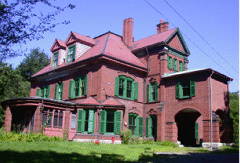Plan for Brooks Estate Put on Hold
 – Allison Goldsberry
– Allison Goldsberry
A plan to renovate the historic Brooks Estate into an income-generating space for holding events has been put on hold.
The Medford City Council discussed the proposal at its meeting last week but didn’t take a vote pending clarification on potential conflicts of interest with a couple of Councilors who either live near the property or have relatives who do.
The proposal is a piece of Mayor Michael McGlynn’s “Chart the Course” capital improvement plan, which he announced at his inauguration in January. The proposal includes two phases- a $2.3 million plan for phase one that would restore the mansion and carriage house into facilities for community use and to generate income; and a $900,000 phase two for better road access to the Brooks Estate, which is located in a heavily wooded area next to the Oak Grove Cemetery. According to Mayor McGlynn, phase one would be funded with a bond and phase two would use Chapter 90 funding.
Supporters and those in opposition to the plan spoke before the Council last Tuesday. Some see the renovation as an attractive way to transform a historic property into a community resource that generates revenue for the city while others say there are more important priorities the city needs to address before sinking money into the Brooks Estate.
According to Tom Lincoln, President of the Medford Brooks Estate Land Trust (M-BELT), volunteers have worked for the past ten years to restore the historic property. That work includes “a huge list” of physical improvements to the landscape and buildings, events and outreach, and planning.
“We have made tremendous progress, and it is time to take a big step forward with the bond funding,” said Lincoln. “We have created a comprehensive Brooks Estate Master Plan to show how we can complete the restoration of this wonderful place as a self-sufficient community asset for everyone in Medford. The goal is to make the Shepherd Brooks Manor and Carriage House into first-class community meeting space and function facilities that will generate the income to pay back the City’s capital investment over time and provide ongoing operating funds. This is a model used all over New England, including places like Waltham.”
Medford resident Carolyn Rosen said the plan doesn’t clearly show that it will bring in enough income to cover the cost of the bond.
“Based upon the information provided concerning the Brooks Estate project, there does not appear to be a good business plan in place. Although there has been a good concentration on architectural drawings and ADA in one building, you cannot run a business just on architectural skills,” said Rosen. “The plan did not have evidence of a balance sheet, cash flow analysis statements nor income statements required to determine the feasibility of such a plan…I believe the fiduciary responsibility between the city and its taxpayers in the care of the city’s assets toward community benefit priority has not yet been met regarding this project.”
In his inaugural address, Mayor McGlynn called the Brooks Estate a “wonderful asset” and “unique jewel” that is historic and offers residents opportunities for outdoor activities such as walking, birding, and fishing. He praised the master plan as a viable way to restore the property and create revenue to cover the bond.
“[M-BELT’s] master plan calls for the restoration of the Brooks Estate to maintain the estate’s natural and historic values. It provides a financial blueprint for self-sufficiency, based on capital investment by the city and amortization through function facility income,” said Mayor McGlynn.
Lincoln said M-BELT is getting councilors more information about the project. He believes the Council witnessed how much support the plan has and is hopeful they will vote in favor of the project.
“On March 20, the Council Chamber was full of people in support of the Brooks Estate, many of whom spoke about this ‘gift from the past, and legacy for the future,’ said Lincoln. “The Medford City Council has been consistently supportive of the Brooks Estate over the past ten years and we are confident that they will vote for the proposed capital bond that is critical for the future. In doing so, the Brooks Estate will join the swimming pool, Hormel Stadium, school technology, and Field of Dreams (all supported by the Mayor and the Council) as a community asset worthy of revitalization.”
According to its website, the Brooks Estate includes 50 acres of land and two buildings, a manor and carriage house. The manor was built in 1880. The city has owned the Brooks Estate since 1942. It was used as a nursing home in 1960’s and 1970’s and is now occupied by caretakers who live at the property. It became a protected asset in 1998.